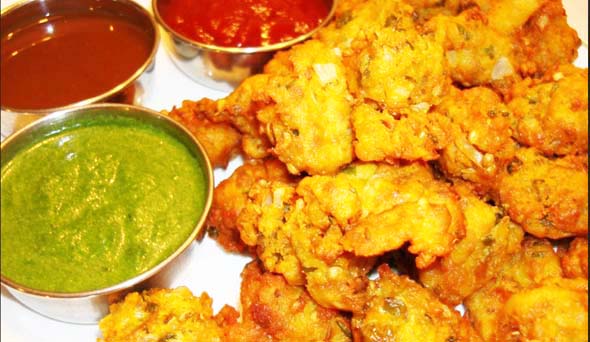Mama’s Punjabi Recipes: Pakore (Fried Fritters)
Some spicy North Indian snacks have become so popular all over the world that they are popping up in the most unexpected places: on the menus of other eateries. Pakore (or pakoras) are just one such item along with samose (or samosas). These inexpensive snacks are usually fried: though a few people try to bake them, the taste is just not the same.
In India, poor people can sometimes make a whole meal eating pakoras rolled up in a roti, with a little chutney. Pakora means covering an edible in a chickpea flour batter and then frying it. Pakoras are satisfying because they can be made with a spicy batter with different vegetables and even with cubes of paneer.
People sometimes confuse pakore with the shredded vegetables balls usually used as an ingredient in a kofte curry, but the main difference is that the kofte have the vegetables mixed into the dough which are then fried. On the other hand, Punjabi kadhi tastes best when made with plain pakoras rather than those with vegetables in them. And then there are the little pakodiyan (chickpea flour drops) that are plain and used in raita. Some people also make pakoras with chicken or fish.
Chickpea flour is also called besan and come from dry roasted garbanzos (or chickpeas) which is then ground. It is high in carbohydrates, but contains no gluten and has a higher protein content than other flours.
Ingredients:
1.5 cups besan (chickpea flour)
Water – enough to make running paste
2 small aloo (potatoes)
¼ head of phul gobi (cauli flower)
Other vegetables: onions, eggplant or bell peppers
Spices to taste: namak (salt), mirch (red pepper)
Directions:
1. Wash the vegetables and cut the aloo into ¼ inch thick chips and separate the florets of the cauliflower into medium pieces. If using other vegetables, you can cut them in similar fashion.
2. Place in a bowl and sprinkle with namak and mirch and let them stay for a while so that they become a little soft.
3. Mix in namak and mirch into 1.5 cups of besan and water till it becomes a soft, running paste.
4. Heat the oil in a karahi (wok). Throw in a small dab of batter to make sure the oil is very hot. Take a piece of vegetable, dip it into the batter then release it into the hot oil. Keep doing this till the surface of the oil is covered with battered pieces.
5. When one side is slightly brown, turn it over using a sieved spatula and turn over a few times to make sure both sides are cooked. Be careful that they do not become dark brown. Take them out and place on a paper towel to absorb the extra oil.
6. Pakoras are best when served hot with some tomato ketchup or mint chutney.
MAMA’S TIP OF THE WEEK
HOW TO CELEBRATE LOHRI
Lohri is celebrated all over the Punjab and by Punjabis everywhere on January 13 – it is one of the few days when the Gregorian and Hindu calenders are in sync – to mark the end of the dark cold nights after the Winter Solstice and the end of the month of Pausa (December-January). It is also a celebration of the winter harvests and the next day is the first of the Hindu month of Magh Sangrand (or Makara Sankranti) which starts off with a kite flying festival.
For Punjabis, Lohri is really a joyous occasion to make the passage of a newly-born son or newlyweds through their first winter. Bonfires are lit at sunset, people toss sesame seeds, gur (jaggery), rewaries (sugar-candies) into it and sit around it, singing folk songs and dancing till the fire dies out. Some people perform prayers; and it is traditional to offer guests til, gachchak, gur, moonphali (peanuts) and phuliyan (popcorn). In a form of trick or treat, people go from bonfires (signifying the house has a new-born) and sing, expecting a treat of sweets or money in return.
Shakuntla Malhotra is a skilled cook of Punjabi dishes made in the old-fashioned style that she learnt as a young woman in her ancestral home in Lyallpur, India before it became part of Pakistan after the Partition in 1947. People have often admired her cooking for its simplicity and taste that comes with each mouthful. Even in her mid-eighties, she continues to cook daily and agreed to share some of her delectable Punjabi recipes.


